Before the war of 1914-18 the French Navy was weakened by a divergence of opinion on policy, but since 1919 great changes have taken place and a well-balanced, powerful fleet has been evolved
FLEETS OF THE FOREIGN POWERS - 2
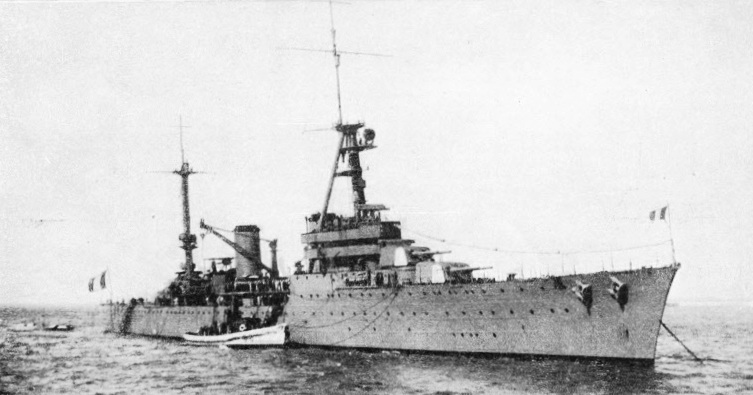
ONE OF SEVEN 10,030-TONS CRUISERS completed between 1928 and 1934 for the French Navy. The Duquesne (above) and her sister, the Tourville, developed on trial a speed of nearly 36 knots. They have an overall length of 626 ft. 8 in., a beam of 62 ft. 4 in. and a maximum draught of 23 feet. Their armament includes eight 8-in. guns, sixteen anti-aircraft guns and six torpedo tubes.
IT has often been asserted that during the years 1914-18 Great Britain gave the rest of the world a demonstration of the value of sea power which every other country except herself promptly took to heart. That there is some truth in this cannot be denied, for while the return of peace was the signal for a drastic reduction of British naval armaments, most of the other great Powers at once set about the creation of new fighting fleets on an imposing scale. France took a prominent part in this movement, and the rebirth of her navy since that time is one of the most striking phenomena of current history.
For at least two decades before the war of 1914-18, French naval policy was vague and erratic. Guided by no definite principle, it was at the mercy of doctrinaires and amateur strategists who had sufficient influence to impose their will on the Ministry of Marine. While one school pinned its faith to battleships and armoured cruisers, another and more powerful body of opinion urged the superior merits of guerilla warfare, to be waged by swarms of torpedo craft and submarines. Between these opposing schools some sort of compromise was eventually struck, but the outbreak of war in 1914 found the French Navy ill-balanced and unsymmetrical.
It contained a large number of armoured ships, but few of these were of the dreadnought type, nor was there a single battle cruiser among them. Fast light cruisers and ocean-going destroyers were conspicuous by their absence, and the large force of submarines, which looked imposing on paper, consisted for the most part of experimental types which proved unsuitable for war service. Some years earlier a French critic had described the national navy as “une flotte des echantillons” (“a fleet of samples”) and although later building programmes were already beginning to restore the balance of ship types, the gibe still retained something of its original point.
During the war years the development of the navy was almost entirely arrested by the overriding claims of the army. Many thousands of seamen were withdrawn from the fleet for service in the field, and the dockyards were converted into military munition plants, work being stopped on all ships under construction with the exception of auxiliaries and anti-submarine craft. Thus the end of the war found the French Navy in a parlous condition, with only a handful of modern ships and no new construction coming along to replace the considerable casualties that had been suffered. Little had been done to remedy this state of affairs when the Washington Conference was summoned in 1921. Then France found herself placed on a footing of equality with Italy in battleship strength, though she vigorously and successfully resisted every attempt to impose a similar restriction on her cruiser and submarine forces.
So far as France was concerned, the Washington Treaty for naval limitation had the reverse effect of that intended, for its exposure of her comparative weakness at sea led her to make a determined effort to rebuild her fleet. To this task she immediately applied herself and has ever since continued with admirable energy and singleness of purpose. France was exceedingly fortunate at that time in having as Minister of Marine a statesman of outstanding ability and strength of character, who devoted himself whole-heartedly to the restoration of the navy. This was Monsieur Georges Leygues, who for more than ten years remained at the helm despite repeated changes of government, and died in harness only a few years ago, having well and truly laid the foundations of a new era of French sea power.
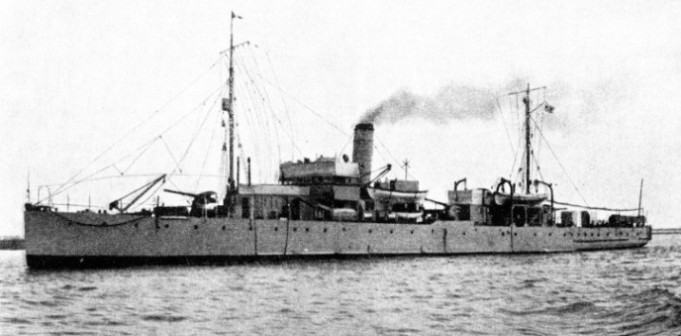
A FRENCH SLOOP is known as an aviso, or dispatch vessel. The Ancre is one of several of this category. Completed in 1918, she has a displacement of 604 tons and a speed of 21 knots. Her armament includes four 3.9-in. guns. She is 250 feet long, and has a beam of 28 ft. 6 in. and a draught of 10 ft. 9 in.
The first post-war building programme was introduced in 1922, since which date naval shipbuilding has proceeded steadily and methodically on an ordered plan. For several years construction was limited to three distinct types — cruisers, destroyers and submarines. Each of these types was divided into two classes, the units of each class exhibiting a remarkable degree of homogeneity. Thus the seven heavy cruisers built by 1936 are uniform in size and armament and differ only in speed. Among the twelve light cruisers there are few differences of importance. All modern French designs are characterized by marked ingenuity and first-class workmanship, a notable example being provided by the thirty five large flotilla leaders, which are really small but heavily armed and extremely fast cruisers.
France has retained her preference for submarines, of which she has ninety-two. The great majority are boats of modern construction, and they constitute an undersea flotilla unmatched in strength by any other navy. Having made good her deficiency in fast surface craft, France has now begun the task of rebuilding her battle fleet. By 1936 one new battleship was already completed, three more were under construction, and several other capital ships of pre-war design had been thoroughly modernized. To-day, therefore, the French Navy, for the first time in modern history, presents
an appearance of almost perfect balance and proportion. Almost the only feature that invites criticism is the apparently excessive number of submarines, which appear to have been built regardless of their strategic functions.
The distribution of French naval force is necessarily governed by geographical and political considerations. France has to provide for the defence of two widely separated coast-lines, on the Atlantic and the Mediterranean respectively. At the same time she has to safeguard the sea communications of her great colonial empire, especially those that link her with the vast territories in North and West Africa, which are among her principal reservoirs of military man power. The bulk of the fleet is therefore permanently stationed in the Mediterranean, with Toulon as the chief base, and Bizerta, in Tunisia, as naval headquarters for North Africa.
Air Force Co-operation
On the Atlantic coast the principal base is Brest, where in 1936 were stationed three battleships of the Lorraine class, a squadron of light cruisers and a strong force of torpedo craft and submarines. Farther north, at Cherbourg, a large flotilla of submarines is maintained. At all the bases powerful air forces are available for co-operation with the fleet.
In recent years France has been seriously concerned about the possibility of a naval attack being launched against her English Channel and Atlantic sea-board from the direction of the North Sea. To deal with this menace she has prepared an elaborate system of defence by means of surface ships, submarines, high-speed motor torpedo-boats, aircraft and mine-fields.
In the Mediterranean French naval policy aims at the firm control in war-time of the triangle which has Oran (Algeria) and Bizerta for its base and Marseilles as the apex, an area covering the vital military route between Marseilles and Algiers. In a national emergency a large volume of transports bringing troops from North Africa would be using this route. Its security is therefore a matter of life and death for France. The new liners recently built lor the Marseilles-Algiers mail and passenger service (they have a speed of 23 knots), were designed in collaboration with the French naval authorities and largely paid for by Government subsidy. These vessels, it has been officially stated, are earmarked for service as fast transports, and others are to be built in the near future.
French naval strategists, however, do not rely exclusively on the Mediterranean route as a military highway in war-time. They recognize that in certain contingencies it might prove impossible to transport troops along this route with a reasonable measure of safety. Therefore they have developed an alternative line of communication between the ports of French West Africa and Bordeaux, a route which completely avoids the Mediterranean and is less vulnerable to attack.
French naval policy, in a word, is dominated by military considerations, for it is felt that in the last resort the fate of the country will be decided on the battlefield and not on the sea. It is, however, an interesting and significant fact that for the first time on record the policies of the iand and sea services have been brought into perfect co-ordination for the advancement of the ultimate objective. Here again we can detect the influence of the war of 1914-18, which taught France the incalculable value of sea power as a means of reinforcing her armies in the field and ensuring them a steady supply of manpower and munitions.
The French battle fleet will not be fully organized till 1940, when the last of the ships now building is due for completion. It will then comprise four battleships of up-to-date design and three older ships which have been modernized. The most powerful units are the Richelieu and the Jean Bart, each displacing 35,000 tons, with a speed of 30 knots and a main armament reported to be twelve 13-in. guns, which may prove to be of 15-in. calibre. The first of these ships was begun in 1935. Next in size and power are the Dunkerque and the Strasbourg, laid down in 1932 and 1934 respectively. They are ships of 26,500 tons, with a contract speed of 291 knots and a main battery of eight 13-in. guns.
The design of these vessels was inspired by that of the British Nelson class, for there is the same concentration of main armament in the forward part of the ship, a similar form of control tower, and much the same lay-out of machinery spaces. On the other hand, the Dunkerque and her sister are armoured on a new system, the armour itself being lighter than that of the British ship but covering a wider area. The eight big guns are mounted in two quadruple turrets forward, the second turret being at a higher level than the first. Each turret is divided by a thick armoured bulkhead into two compartments, so that damage to one pair of guns would not necessarily affect the other pair in the same turret. On the other hand, if the training machinery of the turret were disabled, all the four guns, or half the main armament of the ship, would be put out of action, and for this reason the grouping of so many guns in one turret is open to serious criticism. The secondary armament of sixteen 5.1-in. guns is distributed in three quadruple and two twin turrets.
The First French Dreadnoughts
The three older battleships, Lorraine, Provence and Bretagne, completed in 1915-16, are vessels of 22,189 tons, the speed being 20 knots. Originally they carried ten 13.4-in. guns, and this still remains the armament of the Provence and the Bretagne. The Lorraine, however, now carries only eight guns, the amidships turret having been suppressed to make room for a seaplane catapult. All three ships have been extensively rebuilt, and are still efficient units, their armour and under
water protection being well up to the average for battleships of their date. The secondary armament consists of fourteen 5.4-in. guns in an armoured broadside battery.
Of still earlier date are the battleships Courbet, Jean Bart and Paris, which were completed in 1913-14 as the first genuine French dreadnoughts. In displacement and speed they are uniform with the Lorraine class, but they are armed with twelve 12-in. and twenty-two 5.4-in. guns. These three ships have also been modernized, but the fact that the name of one of them, the Jean Bart, was selected as that of one of the new battleships referred to above suggests that all three vessels will disappear in the course of the next few years. The excellence of their protection was demonstrated during the war of 1914-18, when the Jean Bart was hit by two torpedoes, but remained afloat and was soon repaired.
Finally, there are three old battleships, Diderot, Condorcet and Voltaire, which date from 1911. Belonging to the semi-dreadnought type formerly exemplified in the British Navy by the Lord Nelson and the Agamemnon, they are ships of 17,597 tons, with an original speed of 191/4 knots. They are armed with four 12-in. and twelve 9.4-in. guns, an array of heavy artillery which gives them a most formidable appearance, enhanced by the five funnels, which are a distinctive feature of this class. The ships are, however, almost worn out and liable to be scrapped at an early date.
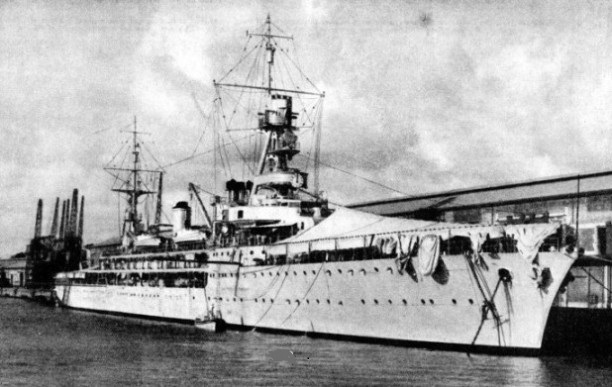
USED AS A TRAINING SHIP. The Jeanne d’Arc, completed tn 1931, is a cruiser used as a training ship and can accommodate 156 midshipmen and cadets and twenty instructional officers, in addition to her normal complement of 505. Of 6,496 tons displacement, she has a length of 555 feet, a beam of 57 ft. 6 in. and a maximum draught of 20 ft. 8 in. The Jeanne d'Arc was built at the Penhoet Yard, St. Nazaire. Her speed is 25 knots.
The French cruiser fleet is almost entirely of recent construction, and its ships are second to none in general efficiency. Seven of them belong to the 10,000-tons class, and in the majority of them, as in the corresponding British vessels, protection has been subordinated to speed and gun-power. The Duquesne and the Tourville, completed in 1928, developed on trial a speed of nearly 36 knots, and the Suffren, Colbert, Foch and Dupleix, of similar design, are all capable of 34 knots. In each ship the armament comprises eight 8-in. guns, with a large number of anti-aircraft weapons, and the equipment includes two or three seaplanes. The seventh and last vessel of this group, the Algerie, completed in 1934, differs radically from the others and is undoubtedly superior in fighting power, since her vitals and turrets have good armour protection which has been fitted without any sacrifice of gun-power or speed.
Among the light cruisers, special interest attaches to the three sister ships Duguay-Trouin, Lamotte-Picquet and Primauguet, as they were the first cruising ships of the naval restoration programme introduced in 1922. Their displacement tonnage is 7,249 and their speed over 33 knots. They are armed with eight 6.1-in. guns in twin turrets, four 3-in. anti-aircraft pieces and twelve torpedo tubes. Shortly after their completion all three ships visited Portsmouth, where their smart and workmanlike appearance — in contrast to the somewhat bizarre, not to say fantastic, impression conveyed by French warships of an earlier date — was the subject of favourable comment in British naval circles. Before 1914 French men-of-war, with few exceptions, were cluttered up with a variety of “gadgets”, the utility of which was not always evident, and designers apparently devoted endless pains to contriving grotesque funnels and upperworks. Of late years, however, all this has been changed, and French fighting ships of to-day are second to none.
Minelaying Cruiser
The second homogeneous group of light cruisers consists of six vessels, La Galissonniere, Jean de Vienne, Gloire, Marseillaise, Montcalm and Georges Leygues, commissioned in 1935-37. The class has a displacement of 7,600 tons and a speed of 31 knots, the armour protection being similar to that of the heavy cruiser Algerie. Nine 6-in. guns are mounted in triple turrets, two of which are placed forward and the third on the quarter-deck. There are also sixteen anti-aircraft weapons of various calibres and four torpedo tubes.
One of the most striking examples of the skill and ingenuity of present-day French naval architects is furnished by the minelaying cruiser Emile Bertin, which was commissioned in 1934. Displacing only 5,886 tons, this ship carries nine 6-in. guns, several smaller pieces, six torpedo tubes, and a large number of mines. Her designed speed is 34 knots, but this was greatly exceeded on her trials, when she averaged 37 knots in a rough sea, and for a short period steamed at nearly 40 knots.
Another distinct type is represented by the Jeanne d’Arc, which went into service in 1931 as a training cruiser for midshipmen and cadets. She is a ship of 6,496 tons with, a speed of 26 knots, and mounts a main armament of eight 6.1-in. guns. Since her completion she has made more than one voyage round the world, proving herself to be an excellent sea boat and a reliable steamer.
The smallest unit of the cruising fleet is the minelaying cruiser Pluton, completed in 1931, with a displacement tonnage of 4,773, a speed of 30 knots, and an armament of four 5.4-in., six smaller guns and over a hundred mines. Alike in speed and fighting power this ship compares favourably with the much larger British minelayer Adventure, 6,740 tons, which was commissioned four years earlier.
In addition to the foregoing cruisers the French Navy contains thirty-five ships which, although officially classed as destroyers, or alternatively as flotilla leaders, are light cruisers in everything but name. In some ways they are the most remarkable vessels of the postwar programme and represent a type of purely French conception. The first group of six, completed in 1926-27, contains the Lynx, Leopard, Tigre, Chacal, Panthere and Jaguar. They are of 2,126 tons displacement, with a designed speed of 35½ knots and an armament of five 5.1-in. guns, eight anti-aircraft machine guns and six 21.7-in. torpedo tubes.
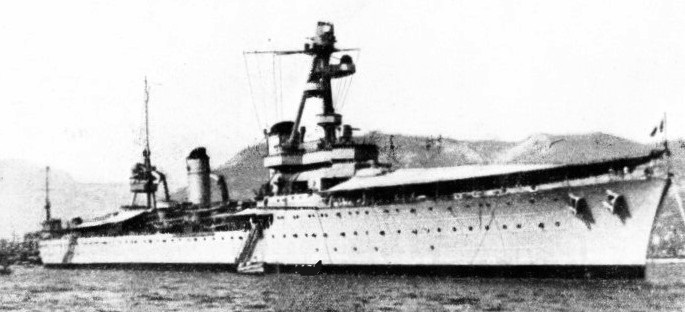
COMPLETED IN 1931, the Colbert is a heavy cruiser with an overall length of 637 feet, a beam of 63 ft. 6 in. and a maximum draught of 24 ft. 6 in. Her geared turbines have a designed horse-power of 90,003 and give her a speed of 32 knots. She has a complement of 605.
They proved highly successful and were admirably adapted to serve either as “destroyers of destroyers”, or as fleet scouts — in other words, as light cruisers. They are ocean-going ships in every sense of the word, for their great size enables them to face any weather, and they have a cruising radius of 3,500 miles at economical speed. Between 1925 and 1935 twenty-nine further vessels of this type were laid down, each group showing a further advance in tonnage, speed and armament. The latest units displace nearly 2,900 tons and have a contract speed of 37 knots; the armament consists of six or eight 5.4-in. guns and nine torpedo tubes. No verbal description can do full justice to these unique specimens of naval architecture.
The Tartu is fairly typical of the “light cruiser” group. Displacing 2,441 tons, she has a length of 424 ft. 3 in. and a beam of 39 feet, and she is extraordinarily roomy above and below deck. In the engine-room are two sets of Parsons turbines taking steam from four water tube boilers fired with oil. Although the contract speed is 37 knots, the Tartu made on trial a maximum of nearly 40 knots. She is strongly built throughout.
Mounted on the centre line are five 5.4-in. guns, each capable of firing fourteen rounds a minute and discharging 88-lb. shells. Guns and torpedo tubes are so arranged that there is no mutual interference. A complete system of director fire-control is fitted, and all instruments and appointments in the ship are of the highest quality. The living quarters for the complement of 220 officers and men are unusually spacious and well ventilated. The impression received from a visit on board her is that she is a highly efficient cruiser, and to use the term destroyer in connexion with such a vessel seems quite irrational. The Tartu can travel 3,000 miles at a speed of 18 knots on one load of fuel, or a much greater distance at lower speed. No other navy has any vessels of this type, whose value if used as cruisers should be great. They are, however, much too large and costly to be used as destroyers.
Of torpedo craft proper France has twenty-six modern destroyers, with an average displacement of 1,345 tons and speeds of 33 and 34 knots, the armament consisting of four 5.1-in. guns and six torpedo tubes. She has also developed a new type of small destroyers known as escorteurs or “fleet escorts”, of which twelve had been completed in 1936. They are vessels of 608 tons with a speed of 34½ knots, and are armed with two 3.9-in. quick-firers and four small torpedo tubes.
The French submarine flotilla is the most numerous and powerful in existence, but it is to be doubted whether its dimensions and quality are fully appreciated abroad. Since 1922 no fewer than eighty-three boats have been built, ranging from the giant under-sea cruiser Surcouf, of 2,880 tons, down to coastal units of 552 tons. As with the cruisers and destroyers, the submarines have been built in homogeneous groups.
World’s Largest Submarine
For example, there are thirty boats of almost identical design, most of them having a displacement of 1,379 tons and a surface speed of 18 knots. In all the armament comprises one 3-9-in. gun and eleven torpedo tubes. Among the vessels of this large group all items of equipment and spares are interchangeable. The coastal, or second-class boats, average about 570 tons, with a speed of 14 knots, and carry seven to nine torpedo tubes. There is also a group of submarine minelayers with a uniform displacement of 669 tons.
The only vessel in the underwater fleet which can in any way be considered a freak is the submarine cruiser Surcouf, which was laid down in 1927 and took nearly six years to build. This monster of the deep is 361 feet in length, displaces 2,880 tons on the surface and has a surface speed of 18 knots. She is manned by a crew of 150, whose living quarters compare well with those to be found in a large destroyer.
The most striking feature of the Surcouf is her armament, which includes two 8-in. guns, the heaviest artillery mounted in any submarine afloat. There are also several smaller guns and fourteen torpedo tubes. In spite of her immense size the vessel can submerge completely in two minutes, and her surface cruising radius at half speed is 10,000 miles.
The French Navy’s large contingent of auxiliary ships includes a number of interesting types such as the diesel-engined sloops built for colonial service, larger and more heavily armed than corresponding types in the British Navy. There is one large aircraft carrier, the ex-battleship Bearn, of 22,146 tons, with a speed of 21½ knots and a capacity of forty aircraft. The only other carrier is the Commandant Teste, of 10,000 tons and 20½ knots. This is a catapult ship not equipped with a flight deck.
In 1936 the personnel of the navy comprised about 3,800 officers and 54,000 men. In recent years the policy of manning the fleet as far as possible on a voluntary basis has been successfully pursued, though it is still necessary to enter a substantial proportion of conscripts. By common consent the backbone of the lower-deck is provided by the Breton element, which has a natural aptitude for sea life. The average age of the officers is higher than that of British officers, but French professiona training is acknowledged to be most thorough.
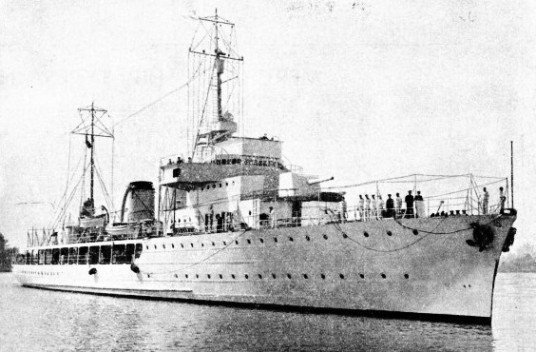
DESIGNED FOR TROPICAL SERVICE the diesel-engined d’Entrecasteaux is one of seven avisos coloniaux, or sloops for colonial service. Completed in 1933, the d’Entrecasteaux has a displacement of 1,969 tons and is armed with three 5.4-in. guns and four smaller, anti-aircraft guns. She is 340 feet long, with a beam of 41 ft. 8 in. and a draught of 14 ft. 9 in She carries one seaplane.
You can read more on “The Chella”, “French Shipping” and
“The Triumph of the Normandie” on this website.







